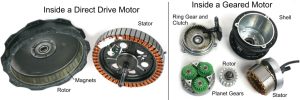What are the Parts of an E-bike?
The Essential Components of an E-bike
When it comes to electric bicycles, commonly known as e-bikes, there are several key components that work together to provide an efficient and enjoyable riding experience. Whether you are an e-bike enthusiast or just getting started, understanding these essential parts is crucial. In this article, we will explore the main components of an e-bike and their functions.
1. Frame
The frame of an e-bike serves as the foundation and backbone of the entire bicycle. It is typically made of aluminum alloy or carbon fiber to provide strength and durability while keeping the weight low. The frame houses all the other components and determines the overall structure and design of the e-bike. Different frame styles, such as mountain bike, road bike, or cruiser, cater to various riding preferences.
2. Electric Motor
The electric motor is the heart of an e-bike, providing the power to propel the bicycle forward. It is usually located in the hub of the rear wheel or in the crankset area. E-bike motors come in various types, including hub motors and mid-drive motors. Hub motors are generally found in the rear wheel or front wheel and provide direct power to that specific wheel. On the other hand, mid-drive motors are positioned near the bottom bracket and deliver power directly to the drivetrain, leveraging the bike’s gears for more efficient performance.

3. Battery
The battery is the energy source that powers the electric motor. It is typically a lithium-ion battery pack, known for its high energy density and long lifespan. The battery is often mounted on the downtube of the frame or integrated within the rear rack. The capacity of the battery, measured in watt-hours (Wh), determines the range or distance an e-bike can travel on a single charge. Higher-capacity batteries allow for longer rides, but they also tend to be larger and heavier.
4. Controller
The controller is the brain of the e-bike, responsible for managing the flow of electricity from the battery to the electric motor. It regulates the power output based on input from the rider and the selected assistance level. The controller also provides various features, such as speed control, pedal-assist levels, and regenerative braking. Some advanced e-bikes even have controllers with Bluetooth connectivity, allowing riders to customize settings through a smartphone app.
5. Display and Control Panel
The display and control panel provide the rider with important information and access to various settings. It typically shows details such as speed, distance traveled, battery level, and assistance mode. The control panel allows the rider to switch between different levels of assistance, adjust settings, and activate additional features. These displays can be simple LED screens or more advanced LCD or OLED screens with backlighting for improved visibility.
Additional E-bike Components
In addition to the essential components mentioned above, e-bikes also include several other parts that contribute to their overall functionality and comfort.
1. Drivetrain
The drivetrain of an e-bike consists of the chain, cassette or freewheel, crankset, and derailleur. It transfers the power from the electric motor to the wheels, allowing the rider to pedal and control the speed. E-bikes often have multiple gears to provide a wide range of gear ratios, enabling riders to tackle various terrains and inclines effortlessly. https://www.theebikespecialist.com.au/electric-bikes
2. Brakes
Brakes are a crucial safety component in any bicycle, and e-bikes are no exception. Commonly used brake types on e-bikes include rim brakes, disc brakes, and hydraulic disc brakes. Rim brakes exert pressure on the rims of the wheels to slow down or stop the bike, while disc brakes use brake pads to clamp onto a rotor attached to the wheel hub. Hydraulic disc brakes offer even greater stopping power and better modulation compared to mechanical disc brakes.
3. Suspension
Suspension systems help absorb shocks and vibrations, providing a smoother and more comfortable ride, especially on rough or uneven terrain. E-bikes can have front suspension forks or full suspension setups with both front and rear suspension. These systems help improve traction, control, and overall ride quality, enhancing the performance and versatility of the e-bike.

4. Wheels and Tires
E-bike wheels are typically designed to be sturdy and durable to withstand the additional weight and forces exerted by the motor and battery. They come in different sizes, including 26-inch, 27.5-inch, and 29-inch, depending on the intended use of the e-bike. Tires also play a crucial role in providing traction, stability, and comfort. E-bike tires come in various tread patterns and widths, catering to different riding conditions, such as smooth roads, gravel trails, or off-road adventures.
5. Lights
Lights are essential for visibility and safety, especially when riding at night or in low-light conditions. E-bikes often come equipped with front and rear lights powered by the e-bike’s battery. These lights can be either integrated into the frame or mounted separately. Some advanced e-bike models even have adaptive lighting systems that automatically adjust the brightness based on ambient light conditions.
6. Accessories
E-bikes offer a range of accessories to enhance convenience and functionality. These can include fenders to protect against splashes and mud, racks or baskets for carrying cargo, kickstands for easy parking, and even integrated locks or alarms for added security. Additionally, riders can personalize their e-bikes with accessories like saddlebags, phone holders, or ergonomic grips to suit their specific needs and preferences.
Conclusion
Understanding the various components of an e-bike is essential for both new and experienced riders. From the frame and electric motor to the battery and controller, each part plays a crucial role in the overall performance and functionality of the e-bike. Additionally, components like the drivetrain, brakes, suspension, wheels, and accessories further enhance the riding experience and cater to specific preferences and needs. By familiarizing yourself with these parts, you can make informed decisions when choosing or maintaining an e-bike, ensuring a safe, enjoyable, and optimized riding experience.




